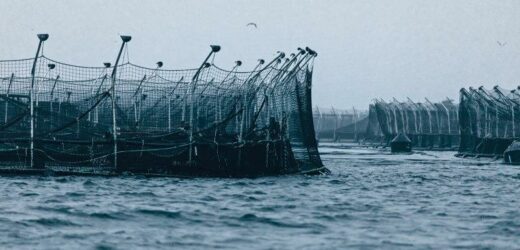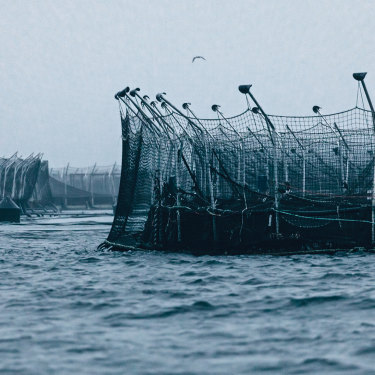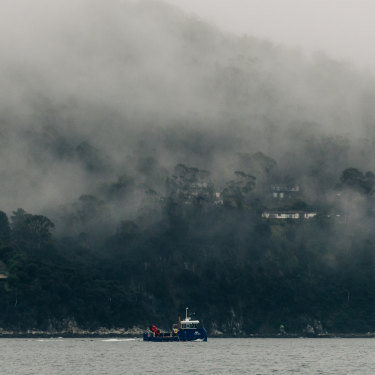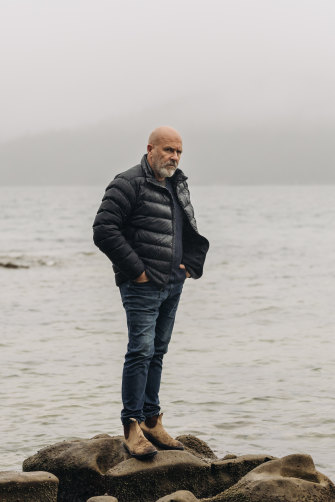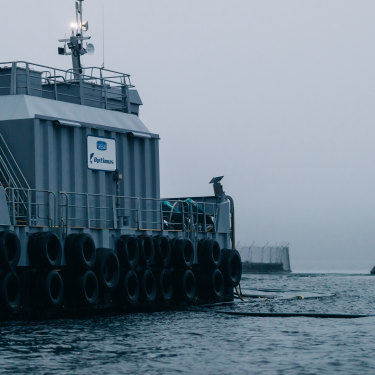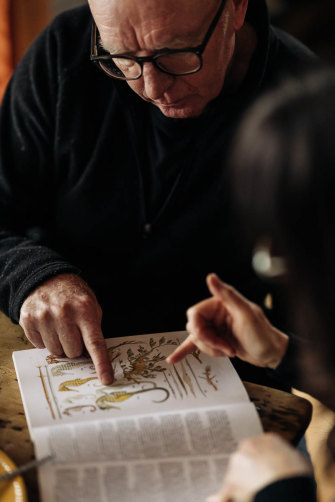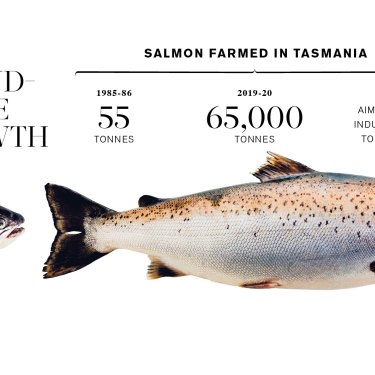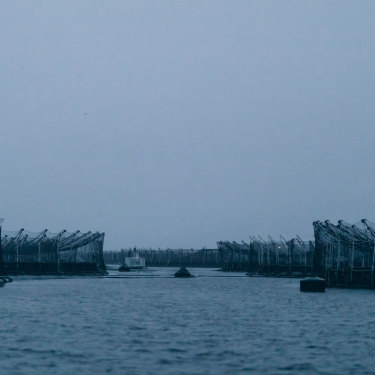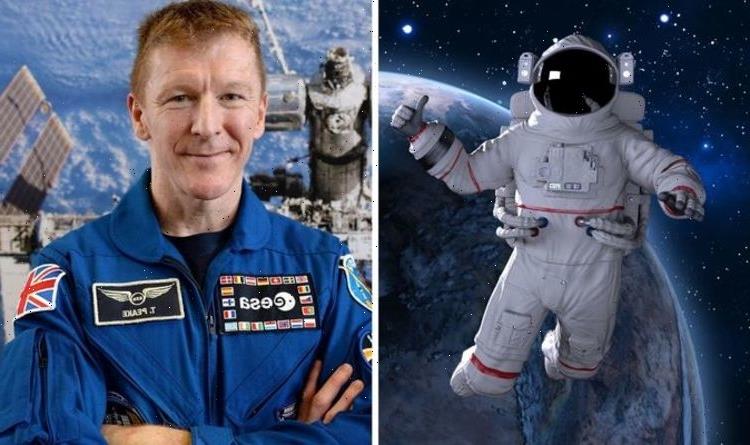By Gabriella Coslovich
Tassal fish pens in the D’Entrecasteaux Channel. The farming of Atlantic salmon in Tasmanian waters, once a niche business, has grown into a full-scale industrial operation.Credit:Adam Gibson
We push off from the jetty before dawn, launching into the water in a dreamy half-light. Shadowy headlands, coastal cliffs and eucalypts shrouded in fog glide in and out of view as we cruise down the D’Entrecasteaux Channel, the waterway between Bruny Island and the mainland of south-east Tasmania. Lines of seagulls sweep alongside us. Gerard Castles is at the wheel of his small but gutsy fishing boat, a Bar Crusher.
“It’s like a pocket battleship,” he says of his recent purchase, which replaces a tinny. Visibility is poor, the rain soft but persistent. Castles jokes that he’s like an ancient mariner, navigating by instinct. Rain flicks into the cabin as he peers through an unzipped plastic window, beanie pulled low over his head. It’s a balmy winter’s morning, 12 degrees with light winds. We’re immersed in the stuff of Tasmanian tourism brochures, otherworldly and serene. “There’s Bligh Point,” Castles says, indicating a hazy light on a promontory to our left.
Castle’s shack – the local term for a beach house – is a bit further south, in Killora on North Bruny. He bought it about 18 years ago. “We paid $40,000 for it, with a tinny, cutlery, crockery, TV.” There’s the promise of scones and a wood fire back at the shack, but we’re not heading there yet. Castles is taking us a little further south to see one of the Atlantic salmon farms that have proliferated through the channel over recent decades, like clusters of pimples breaking out along the coast.
We’re going to a lease site 1.5 kilometres across the water that’s owned by Australia’s biggest producer of farmed salmon, Tassal. Since starting in the state in the mid-1980s, Tasmanian farmed salmon has grown to a $1 billion-a-year business, its turnover almost more than that of the state’s dairy, beef and potato industries combined, with most of the fish sold nationally, the rest headed to export markets mainly in Asia. That business is split among market leader Tassal – which in 2019-20 harvested a whopping 34,395 tonnes of salmon, more than half the weight of the Sydney Harbour Bridge – and its closest competitors Huon Aquaculture (25,566 tonnes) and Petuna (about 6500 tonnes).
When Castles bought his shack, the salmon farm across the water was small. There were only a few pens, and feeding was done by hand. In 2005 it was bought by Tassal, and over time the pens multiplied. As the site grew, so did the noise, the light and the marine traffic. The farming process became more mechanised, with operations running at all hours, ships working through the night, illuminating the darkness, piercing the quiet, until this tranquil stretch of water began to feel like an industrial zone. At first, Castles and the other “shackies” of North Bruny would send polite, hesitant emails to Tassal asking if something could be done about the noise.
“We were prepared to put up with it because no one wants a fight, really, and we just wanted to go down there and have this peaceful little bolthole,” he says. “And they were pretty good. They had noise consultants come over, and investigated issues, and they invested in the farm and fixed issues along the way. But as production ramped up and up and up over the decade and a half, noise increased, boat traffic increased, and Tassal’s attitude increased … We reached a dead-end with the company.”
Castles slows down as we approach the first of a long line of salmon pens, huge open-net cages floating in the sea. After being transferred from freshwater hatcheries, salmon are grown in these seawater cages for 12 to 18 months until they’re big enough to harvest. These particular pens are about 120 metres in diameter and when fully stocked, each might hold 150 tonnes of live fish. Two tank-like feeding barges are anchored near the pens. This morning, the site is quiet; when it’s going, Castles says, it sounds like a convoy of idling trucks. We coast past a canyon of pens cordoned off with black buoys. Castles estimates there are about 22 here, “and each can produce the equivalent of 2000 people’s sewage”.
In the dim morning light, the pens have a sinister beauty, appearing like rows of giant floating crowns, or huge trampolines at a strange water theme park. But for many of the people who live near the farms, there’s nothing beautiful about them. In their eyes, the cages are symbols of an industry that has grown too fast, too big, too powerful. While government lauds the money and jobs salmon brings to the state’s small and disadvantaged economy, locals are becoming increasingly intolerant of its impact on their lives and the seas in which they fish, swim, paddle, snorkel, surf and dive. “We spent 15 years trying to reduce the noise, then we started digging and found out what was underneath those cages,” Castles says. “What’s under there is a sewer.”
A Huon Aquaculture boat travels up the D’Entrecasteaux Channel, which locals say is polluted by effluent from fish farms.Credit:Adam Gibson
Australians love their salmon and eat it in the belief that it’s a kind of
superfood: cholesterol-busting, beauty-boosting, cancer-preventing, mental health-promoting, dementia-beating. We eat it, too, believing it to be sustainably grown in the clear waters of our southern-most state. Celebrity chefs from Sydney’s Tetsuya Wakuda, an ambassador for Brand Tasmania, to Curtis Stone, who stars in ads for supermarket giant Coles, have lent their cachet to this most democratic of seafood, an everyday luxury available in supermarkets nationwide. Huon Aquaculture’s new marketing campaign, “Give chicken the night off: serve up some Huon salmon”, says it all about how ubiquitous salmon has become on family dinner tables.
We’ve imbibed the message and our appetite for Atlantic salmon – which is only farmed here as Atlantic salmon is not native to our waters – has helped fuel the industry’s growth. (Australian salmon, a wild-caught, coastal fish, is unrelated to Atlantic salmon.) What started as a boutique operation producing 55 tonnes of salmon in 1985-86 has expanded to become a key Tasmanian industry that in 2019-20 produced about 65,000 tonnes of fish, farmed on 2670 hectares of sea across seven marine zones.
And it won’t end there. In December 2017, the Tasmanian government’s Sustainable Industry Growth Plan for the Salmon Industry (Salmon Plan) stated that it would support the industry to become a $2 billion business by 2030, through innovation and by trading on Brand Tasmania to grow national and export markets.
That target is cause for alarm, according to the state’s most distinguished author, Richard Flanagan. In his incendiary new book, Toxic: the Rotting Underbelly of the Tasmanian Salmon Industry, the Booker Prize winner asks exactly what it is we’re consuming when we eat Tasmanian salmon. His appetite-crushing answer? “We eat horror.”
In this, his fourth non-fiction book, Flanagan guts and fillets the salmon industry’s clean, green image, and along with it the successive state governments he accuses of betraying ordinary Tasmanians in favour of the salmon bosses. The complaints are not new; for years now, a growing chorus of Tasmanians has argued the salmon industry threatens the very thing that makes Tasmania special and that is central to its brand: its natural environment. But in Flanagan, they have a nationally and internationally recognised voice arraying their concerns over 224 devastating pages, complete with 270 endnotes; a tsunami of evidence relayed with an award-winning novelist’s flair for metaphor, synthesis and story-telling.
“A Tasmanian Atlantic salmon is the battery hen of the sea,” Flanagan writes in the slim volume, released by Penguin in April. Grown in “gigantic floating feedlots”, the fish are condemned to circulate in “a soup of shit and ammonia”, fed pellets that include “synthetic dye”, antibiotics and “the macerated remains of battery hen beaks, skulls, claws, guts and feathers once destined for abattoir waste streams”. Also in their food is “fishmeal made from jeopardised fish stocks stabilised with a pesticide also used to stop car tyres cracking that happens to be a carcinogen, and soy meal that has possible links to slave labour and the deforestation of the Amazon and the destruction of the Cerrado and that drives global heating”.
So much for giving chicken the night off. In chapter after chapter, Flanagan details the exceptional measures that must be taken to grow the “wrong species in the wrong environment”, a species originally farmed in the cool waters of Norway’s fjords that is simply not suited to Tasmania’s warmer – and increasingly so – waters.
Toxic has struck a chord in the state. Within a month of publication, it was already on its fourth print run, and within two months it had become the fastest-selling book in the 101-year history of the famed Fullers Bookshop in Flanagan’s home town of Hobart. “Its performance has been extraordinary,” says Fullers manager Tim Jarvis, who reports that more than 1700 copies were sold in its first two months alone. “To put it in perspective, our number one book of 2020, Cassandra Pybus’s Truganini, sold roughly the same number of copies in 15 months that Toxic sold in two months. We have never seen anything like it.”
The word is slowly spreading to the mainland, too. Stephen Peak, head chef at The Agrarian Kitchen, a high-end restaurant and tourist destination in New Norfolk, a 30-minute drive from Hobart, has noticed “no salmon” appearing on the dietary requirements forms customers are asked to submit before visiting. “I would say that’s a direct link to the book, because I have not seen it before,” Peak tells Good Weekend. As it happens, The Agrarian Kitchen has never served farmed salmon; Peak says it doesn’t fit its sustainable food philosophy.
In the wake of all this, the industry is scrambling to regain control of the message – and the public’s confidence. United in crisis, the three main salmon companies – not traditionally known for cordial relations – have appointed a shared “facilitator” in the guise of former state Labor minister Julian Amos to help communicate their case.
A registered lobbyist, Amos is a former chair of the Forest Industries Association of Tasmania and has previous business interests in mining, fossil fuels and aquaculture. Writing in Hobart’s daily newspaper The Mercury in late May, the newly appointed spokesman for the Tasmanian Salmonid Growers Association reasserted salmon’s position as “a healthy food”, “free from growth hormones, which are not used at all, or antibiotics”, and high in omega-3. “Flesh is not dyed,” Amos wrote. “That is a silly comment.” He went on: “Just because somebody writes that something is bad doesn’t make it so. Far from being cowboys in a paddock, this industry brings to the table a social responsibility, a realm of science and a commitment to transparency emulated by few others.”
As Flanagan’s critics accuse him of hyperbole and of cherry-picking information to present an unbalanced argument, Toxic makes the case for everyone – from politicians to industry leaders to everyday Australians – to see what’s at stake. “Unless checked, [salmon farms] will destroy so much more of what is unique and offers Tasmania a future in the 21st century.”
Richard Flanagan originally intended to pen a short article about Tasmania’s salmon industry, but after hearing so many “shocking” stories about it, he ended up writing a book, Toxic. Credit:Adam Gibson
Richard Flanagan didn’t intend to write a book about the Tasmanian salmon industry. “I thought I would write a short article,” he tells me when we meet at a popular North Hobart cafe three weeks after the book’s release.
“And I set out to write it and I began talking to other people, and I began putting their stories together and the article started to grow and grow, it couldn’t be contained in an article, and the stories were so shocking.
“Of course I wrote the book in the hope things would change but in another way I’ve just learnt that what matters is you bear testimony to what you see, and that if you can do that with enough honesty and craft, then people respond to that truth. But how they respond I don’t know. These things always take time to have impact, truth is slow, but what I’ve learnt over the course of my life is that it does finally have a power.”
Flanagan is curved over our small wooden table, leaning in to make himself heard above the noise of the packed cafe. At 11am the temperature is still in single digits and few have ventured to outside tables. Flanagan keeps his jacket on, his blue beanie close at hand on the table. He wrote Toxic in eight months, he tells me, and did so in secrecy. His publisher knew what he was working on, of course, but few others did.
Booksellers bought in on the strength of Flanagan’s name and the proposed title. The secrecy was to prevent the salmon companies from placing an injunction on its publication. “I don’t think Australians realise how fraught freedom of speech is in our country at the moment. Our libel laws and our corporate laws are being used to prevent the truth coming out.”
In the book’s opening chapter, Flanagan tenderly describes his family’s “heart-place”, the shack on North Bruny where he’d go to write, sometimes living there for six months of the year. It’s near Gerard Castles’ shack; the pair studied history together at the University of Tasmania. They witnessed changes to the waters of North Bruny together, too. “The thing that made me decide that I had to do something was that I realised the sea all around me was dying because of the salmon farms.”
In staying silent for so long, he says, he was complicit in what he saw happening. “We went to the government, who told us they could do nothing about it and to go to the salmon company. Well, only in Tasmania would you get told that you’ve got to deal directly with the business. But we did, and we tried to work with them in good faith, and after 15 years everything had only got worse.”
Nearing 60, Flanagan has lost none of his fervour. His eyes spark with a deep love for his state, matched by a deep anger for the people who run it. “It’s incredible that we’re now nearly a month out, three weeks since the book first appeared in Hobart, and not one politician – there’s no denial of any of the claims,” he says. “Not one government politician has said anything about major threats to public health, of an industry that’s gone rogue and which seems to run the government rather than the government regulate it, and I fully expect they will say nothing … it’s shameful.”
By sheer coincidence, Toxic was released in the week of the Tasmanian state election. It had no obvious effect on the result; the incumbent government of Premier Peter Gutwein was re-elected in a third consecutive win for the Liberal Party. As with other battles in the state, including with now-defunct forestry giant Gunns in the mid-2000s – which Flanagan has also written about – he suspects change will only come when forced upon the state from the outside. “Change for the better comes because Tasmanian people stand up for what they love about this place, but they have always had to take their fight nationally and sometimes internationally,” he says. “And that’s been the case for everything from the Franklin [River] to gay rights to Indigenous rights, on and on and on.”
Flanagan no longer writes his books at his shack on North Bruny. He occasionally visits, but can’t write there any more, and in fact has listed the property for sale. The listing prompted a front-page story in The Mercury (“A Tale of Two Shacks”), triggering sniffy comments about whether one should believe the real estate agents’ spiel about the serenity and beauty of Bruny Island and the oysters at one’s doorstep, or Flanagan’s mournful depiction of an island depleted. I ask Flanagan whether he stopped visiting his shack because of the noise. “It’s because of the sadness of what’s happened.”
A feeding barge at the Tassal salmon farm on the D’Entrecasteaux Channel houses a diesel plant that powers automated fish feeding. Noise from the site causes distress for the nearby Killora community.Credit:Adam Gibson
Richard Flanagan dedicates Toxic to “all the brave women” who helped him write it. On a Thursday evening in early June, I’m sitting in the lounge room of one of them, Louise Cherrie. She’s in a high-vis orange vest and black lace-up work boots, having just arrived home from seeing a large industrial client. A consultant in environmental management, Cherrie joined the Tasmanian government’s Marine Farming Planning Review Panel in January 2018 to advise on the salmon industry’s planned expansion into Storm Bay in the state’s south-east. She believed in a sustainable salmon industry and wanted to help prevent a repeat of Macquarie Harbour.
In the late 2010s, at least 1.35 million farmed salmon died from disease and oxygen depletion as a result of severe overstocking at Macquarie Harbour, on the west coast of Tasmania and partly in a World Heritage area. Farms were first established in the harbour in the 1980s, with Tassal starting operations there in 2003, Huon in 2008 and Petuna around 2011. The industry began to expand massively in 2012 and by July 2016, the government allowed up to 21,500 tonnes of fish a year to be farmed there (since revised back to 9500 tonnes).
Later that year, environmental monitoring found record low levels of dissolved oxygen on the harbour floor and the presence of bacterial mats at some lease sites. The seabed below and around one of Tassal’s three farms in the harbour, its Franklin lease, was found to be virtually devoid of life, threatening an endangered species, the Maugean skate, and a World Heritage area.
On the panel, Cherrie argued that it was vital for biogeochemical models of Storm Bay to be completed before fish farms went in – that is, studies that would show how the marine environment would respond to the impact of fish farms and the nutrient loads (fish faeces and waste feed) released from pens into the sea. She argued that the industry’s adaptive management had failed in Macquarie Harbour and that such an approach was inappropriate for Storm Bay, in what would be the state’s largest ever industrial development.
“I was openly shut down in meetings, I was openly told I was wrong,” she says. “We know from global and local experience exactly what will happen if farming practices are inadequate or a virus occurs. I was asking for plans based on what we know, not the deflection and obfuscation that is ‘adaptive management’. No other industry is allowed to operate in this way. I know because I help many clients develop their environmental risk management plans.”
Dissatisfied with the information – or lack thereof – presented during the panel sessions, Cherrie went searching for answers in her own time. She went to the state’s Environment Protection Authority and asked to see the footage of the worst cage in Macquarie Harbour. “I wanted to see, if we get this wrong, how bad will it be?” The footage showed “piles and piles of fish waste, bacterial mat and worms all over it feeding” under the cage. That cage should have been de-stocked immediately, Cherrie says. “Instead, it took eight months for tangible operational action to occur. Eight months later? That’s a lack of management, not adaptive management.”
After researching what happened at Macquarie Harbour, she sat up until midnight to write a presentation for the panel arguing that adaptive management had failed there and could not be relied upon as a basis for expansion into Storm Bay, only to be told by its chair that it was too late to present new information. Cherrie resigned from the panel, as did a fellow scientist, Professor Barbara Nowak, a specialist in aquatic animal health and biosecurity. Neither wanted their names on the sign-off to Storm Bay.
“We started digging and found out what was underneath those cages. What’s under there is a sewer.”
It didn’t change the result: in 2018, the salmon companies were given the green light to expand into Storm Bay, in three areas with multiple farms, initially to produce a combined total of 30,000 tonnes of fish a year, with the potential to increase production to 80,000 tonnes a year. The expansion was approved with just three sitting members of the panel and two expired members to make a quorum of five. “I’m not an activist at all, and I respect people who are, but I have always taken the view that I could make better, more tangible change from the inside,” Cherrie says. “But this has been the one time that I haven’t been able to do it and it is the one time I’ve spoken publicly against a development.” She feared that in speaking out, she might lose some of her clients. She hasn’t lost one.
“It’s so funny how many high-vis, big, burly guys are saying, ‘Good on you, this is wrong, I can’t catch a fish where I used to, I’m sick of what I’m seeing on the beaches, we ran into some bloody piping one day in the boat and it was unsafe.’ When people like me in their high-vis start saying, ‘No, this is wrong’ … don’t dismiss it as ‘NIMBY’ and ‘green’ issues. It’s not. This is a mainstream problem.”
She no longer believes in a sustainable salmon industry, but she won’t be advising people not to eat its products. “I don’t like to tell people what to do. If somebody wanted to eat salmon and that’s an informed choice they’ve made, go for it. Sometimes I have McDonald’s, and I know that’s junk. If I ate salmon, I would know I was eating junk food, and I would make an informed choice about that.”
Some politicians have been listening: a group of independents from Tasmania’s Upper House set up a Fin Fish Farming Inquiry last year in response to consistent community concerns about the industry. Interrupted by the state election, the inquiry is expected to release its findings later this year, although some fear its recommendations will end up as a report that sits on a shelf.
The inquiry received 225 formal submissions and held public hearings from February through to November last year. The lack of transparency in the way fish farms are approved and regulated was raised over and over, including by the Shooters, Fishers & Farmers Party Tasmania, not an organisation one necessarily associates with “green” issues. The Environmental Defenders Office, a non-profit community legal service, highlighted the conflict of interest at the heart of a system where the Minister for Primary Industries was responsible for both promoting the industry and regulating it. Huon Aquaculture’s co-founder and co-owner, Frances Bender, made a fiery appearance, telling the inquiry: “I have read and listened to comments that, at best, I could label apocryphal and, at worst, blatant lies of our industry, our business, our employees and myself.” The inquiry’s chair responded: “It’s a shame that the committee process is called into question.”
As might be expected, most of the submissions to the inquiry criticised the salmon farms’ operations, but the farms’ supporters emphasised the jobs they provided, particularly for young people, and in regional areas. “The amount of financial support that Tassal has given our sporting and community groups is unprecedented since the demise of the woodchip mill,” one Triabunna resident wrote.
Just how many jobs, however, is another sticking point. The industry claims to support 12,000 Tasmanian jobs indirectly but a local economist, Graeme Wells, writing in The Mercury, called this an exaggeration, estimating that at most the industry provides 4400 jobs indirectly. The three salmon companies directly employ about 2300 people – many other sectors, such as hospitality and education, employ far more than that – but in a state with consistently high unemployment rates (recording the country’s highest in April at 6.2 per cent), jobs are a foil against criticism.
“What’s the financial benefit for Tasmanians in the end? Is it worth putting our environment at risk for?” says professional diver Greg Woodham, who is angered, too, by the minimal fees the companies pay for their use of public waterways. A study published by The Australia Institute in 2019 estimated that this $1 billion industry paid about $920,000 to the state government in annual lease and licence fees.
“What’s the financial benefit for Tasmanians in the end? Is it worth putting our environment at risk for?”
Woodham has been a professional abalone diver for almost 47 years. He doesn’t bother diving in the D’Entrecasteaux Channel any more because of the algal growth choking the sea, which he puts down to the nutrient load being released from the salmon farms. He’s seen growing problems on the Tasman Peninsula, too, and talks of a boat ramp at Port Arthur opposite a Tassal farm that’s become so clogged with weeds that it’s nearly impossible to get a boat in and out.
“I am not a specialist,” Woodham says, “but for us, we in the abalone fishing industry, we dive in areas where there is salmon farming and it’s obvious that there are more nutrients than in the past.”
Walter Meyer, a recreational diver in his 70s, tells a similar story in the short film Paradise Lost, directed by Justin Kurzel of Snowtown fame and Conor Castles-Lynch (Gerard Castles’ son), that accompanied the release of Flanagan’s book. Meyer’s favourite diving spot used to be around Huon Island, which lies at the confluence of the Huon River, the D’Entrecasteaux Channel and the Southern Ocean, a “secret garden” once rich with abalone, crayfish, mussels, leatherjacket. Meyer’s underwater footage shows a garden destroyed: murky water, seaweed and marine plants covered with a dusty brown substance, the fish gone. “It looked, like, nuked or something,” Meyer says. “It looked dead.” He puts this down to the effluent flowing in from fish farms about three kilometres away.
Gerard Castles at his North Bruny shack. “No one wants a fight, really,” he says. “We just wanted to have this peaceful little bolthole.”Credit:Adam Gibson
Not one of the heads of the three major salmon companies was prepared to be interviewed by Good Weekend. Nor was the Minister for Primary Industries, Guy Barnett. “For what it’s worth,” Good Weekend was told via email, the government would not be “providing a critique of Richard’s book”.
In search of someone to talk to from the industry’s side, I was directed to Julian Amos, spokesman for the Tasmanian Salmonid Growers Association. Thus, on a Thursday morning in late June I find myself sitting down with Amos at a cafe on Hobart’s Salamanca Square close to Tassal’s retail outlet, The Salmon Shop, where a board out front encourages us to “switch it for salmon”.
An official tour with Tassal’s rival, Huon Aquaculture, had been planned for this day. A date was set, re-set, cancelled. It’s been a busy week for the industry. An Environment Tasmania right-to-information request has unearthed shocking photographs of seals mutilated and killed as a result of the deterrents used against them by salmon farmers. One seal had a beanbag round hanging out of its eye, others horrific flesh wounds. The same week, mining boss Andrew “Twiggy” Forrest invested almost $20 million in the publicly-listed Huon, buying a 7.33 per cent share in the company, which had posted a $95.3 million loss for the six months ended December 31, 2020. In all, possibly not the best time to invite a journalist to the farm.
And so, Salamanca Square it is. Amos and I sit in sunshine at outdoor tables. It’s a mild winter morning, about 14 degrees, but our interview gets off to a frosty start. White-haired and bearded, described in The Mercury as an “old Labor warhorse”, Amos has the world-weary air of someone who has been through a few scraps, and doesn’t hide his irritation at some of my questions. He shrugs, stares and sinks back into his chair. I wonder if he’ll simply walk off. To his credit, he persists. Neither of us are enjoying this. He has possibly one of the hardest public relations jobs in Australia right now.
A couple of blokes walk past and call out jokingly, “You know you’re toxic!” Friends? I ask. “Indeed, old colleagues,” he says.
I want to know about the industry’s plans to double its value to $2 billion by 2030. How will it do this if not by putting more fish in pens, or more pens in the sea? Amos assures that the industry will not double in size. The doubling of value, he says, “will happen by expansion into or getting involved in other species, getting involved in other states, improving the survivability of the fish that are in the pens, utilising new technology, both on farm and in the remote feeding approach to bring about greater profitability”.
I ask whether this doubling in value will result in a doubling of jobs. “No,” Amos says. “If you’re improving your technology it improves your profitability, it doesn’t automatically lead to increasing employment.” I later ask the Tasmanian government how the salmon industry will double in value if not in size, and the response seems at odds with that given to me by Amos: “The government is currently assessing spatial and technological requirements for salmon farming; this includes both increased production from existing marine fin fish farming leases and assessment of new areas suitable for farming fin fish.”
I ask Amos about the expansion into Storm Bay and the concerns raised by independent scientists about the amount of fish to be produced there and the impact increased nutrients might have on the marine environment and on Hobart’s main river, the Derwent, into which Storm Bay feeds. Currently, Huon has five leases on the western side of Storm Bay and only three at present are stocked with fish. Tassal has five leases on the eastern side of the bay, near Wedge Island, one of which has a licence and is stocked with fish, and another has also been given a licence and will be soon stocked with fish. Petuna has recently been granted a lease at the northern end of the bay but it’s not yet operational.
Amos tells me that the total biomass in Storm Bay will be “around 20,000 to 30,000 tonnes, less than 30,000 tonnes; 30,000 is the limit that has been recognised as being a responsible limit, very conservative while the biogeochemical survey is completed”. I mention the over-stocking disaster at Macquarie Harbour, from which Amos tells me there were “significant learnings … not just for the industry, but for the government and government agencies as well”. He says a soon-to-be released report by the state’s Institute for Marine and Antarctic Studies, which monitored the seabed, water and reef habitats at the longest operating lease site on Storm Bay, found no evidence to suggest farming has had an influence on the water quality, soft-sediment and inshore reef habitats.
Concerns about marine debris? The salmon farmers aren’t the only ones that use the sea, Amos says. “The last survey the industry did in areas that it was in found 90 per cent of what they found was not actually from fish farms … I’m not trying to transfer the blame to someone else, what I am saying is the [industry] is a convenient scapegoat in many ways.”
Internationally, there’s a growing movement towards land-based salmon farming in closed-loop systems that have less impact on the environment and require fewer pesticides and antibiotics to be used on fish as they are less prone to seaborne diseases. Are Tasmania’s salmon farmers considering such a move? It’s not commercially viable, Amos says, and he doubts there’s enough electricity in the state to power these farms, which would need artificial currents for the fish to swim in. “Even though people are saying this is a solution, what they are really saying is, ‘We know it’s not commercial so therefore we’re sounding positive but at the end of the day we’re going to close you down,’ ” Amos says.
But it’s not just the environmental impact of fish farms that is causing concern; the healthiness of the salmon itself is under scrutiny. As Flanagan outlines in Toxic, the fish are fed pellets containing synthetic astaxanthin, which gives the fish its peach-coloured flesh. Wild salmon gets its colour from astaxanthin naturally found in the small crustaceans it eats. I mention that in the US, supermarkets were forced to label farmed salmon “coloured” following a class action.
I could have mentioned, too, the legal tussle in 2017 between Huon and one of its fish-feed suppliers, Ridley. Ridley sued Huon for failing to pay for feed supplied between February and July of 2016. Huon hit back, saying the feed didn’t have enough pigment in it, which cost Huon sales and reputation, and triggered compensation claims by customers. Yet Huon’s “fact sheets” continue to state “that there is no dye, or colouring, used at any point in salmon farming”. Tassal’s website also states that its fish are not dyed or coloured. After a verbal wrangle over the main use of astaxanthin, eventually Amos concedes that it “does provide colour to the flesh”.
I put it to Amos that there’s a dissonance between what the industry is saying and what people are seeing and experiencing and discovering. Who is telling the truth? “I am, the industry is,” he says. “Richard talks about ‘the battery hens of the sea’, right, but it’s bullshit, it’s a nonsense … Every [industrial farming] process involves a certain level of activity that some people might find upsetting but in terms of the health of the fish in this industry, there is no issue regarding its safety, there is no issue regarding its health, the idea of it being the battery hen of the sea or living in a swirl of filth – I mean, is hyperbole, it’s exaggerated, it’s flamboyant literature, but it’s not the truth.”
Transparency and trust appear to be at the heart of the divide between the industry and the locals speaking out against it. The industry says it’s subject to all manner of regulations; locals say all manner of regulations count for nothing if regulations are not enforced. The government says it’s “reviewing existing monitoring practices and developing a new Environmental Standard aligning with best practice for Tasmania”. The devil is in the detail, and to find the detail about the operations of the salmon farmers, one needs to trawl through websites or make freedom-of-information requests. It doesn’t seem to serve anyone.
The first experimental salmon farms were established in Norway in the late 1960s. Today, Norway is the world’s largest producer of farmed salmon. According to the Norwegian Seafood Council, in 2019 Norway exported more than one million tonnes of farmed salmon to more than 100 countries, which represents 14 million meals of Norwegian salmon eaten every single day. These figures make Tasmania’s industry seem like a goldfish bowl. But Frederik W. Mowinckel, a relative of one of Norway’s pioneering salmon farmers, wishes his family had never been involved in the first place.
Mowinckel lives in Portugal these days, but when we speak via Zoom he’s in Bergen, Norway, to attend the annual general meeting of Mowi ASA, the world’s biggest salmon farmer, which still references his family’s name, against the family’s wishes. In 2020, Mowi produced 440,000 tonnes of salmon, with farms in Norway, Chile, Canada, Scotland, Ireland and the Faroe Islands.
The Mowinckels sold out in the 1980s. “We didn’t want to be part of this whole industrialisation of what we created, and we disagreed with the lack of environmental consideration and we could see where this was heading, in the wrong direction, and that’s why we sold out,” Mowinckel says.
He bought back into the company, just as he did with each of the listed open-pen salmon farming companies in Norway, so that he could have a say at their annual general meetings, generally to protest against dividend payments, which he believes the companies should invest in protecting the environment. “Excuse my French, but these companies are f…ing with nature, and that’s not on,” he says.
“Tasmania is one of the world’s greatest assets, it’s in all of our interest to respect and protect her.”
But as an “eco-industrialist” (he part-owns a factory that produces materials from waste wood and has other investments in environmental technology companies), Mowinckel is a pragmatist. “It’s too late to get rid of farmed salmon – the market is too big, there are too many people who still love the stuff. The only solution is to turn it into a proper industrial process where you control everything that goes in and what comes out, just like any land-based industry. Simple as that.”
The way to do that, he says, is to move salmon farming onto land, and produce it in a closed-loop system that reduces the impact on the environment. He’d prefer that people stopped eating farmed salmon, but “that’s like saying we can’t eat chicken any more.”
Source: UTAS; Tasmanian Government Department of Primary Industries, Parks, Water and Environment submission to the Fin Fish Inquiry; Tasmanian Salmonid Growers Association.Credit:Getty images
In Tasmania, the grassroots push for change continues. A month after the release of Flanagan’s book, hundreds of surfers take to the sea at Clifton Beach south-east of Hobart to protest against fish farms. A large banner appears on one of Hobart’s old industrial chimneys with the words Fish Farms Harm. In late June, the Bob Brown Foundation advertises for a dedicated fish farms and marine campaigner to lead its new campaign “to halt and reverse the destructive expansion of fish farms in Tasmania”.
Artist and performer Kirsha Kaechele – wife of MONA owner David Walsh – brings glamour and levity to the debate, posting a spoof video on social media as an action-movie heroine backed by troops of divers and fighter pilots leading an assault on salmon farms. By mid-July, 25,000 people have signed non-profit group Environment Tasmania’s petition aimed at supermarkets, asking them to stop buying from “the worst producers”. About 20,000 of the signatories are from the mainland. It demands that supermarkets label salmon as “farmed”, as well as disclose antibiotic use, amounts of faecal waste ending up on the ocean floor, marine life killed, salmon mortalities and escapes (potential ecological impacts), and deformities in hatchery stock.
“There’s nothing new in Richard’s book. But the way he has pulled it all together is brilliant. We have a voice because of Richard.”
Jilly Middleton, a campaigner with Environment Tasmania, says hitting the salmon companies where it hurts – at the cash register – will be more effective than any protest. “In the past, we’ve seen regardless of the amount of noise we make in Tasmania, until there’s a commercial risk to the salmon companies nothing’s going to change in a big way.”
Judging by the response of Australia’s two biggest supermarket chains, Coles and Woolworths, when asked by Good Weekend for their views on Tasmanian salmon, major change is not on the agenda. In an emailed statement, Coles says the supermarket labels its seafood as either wild-caught or farmed and that its “Responsibly Sourced Seafood Program recognises a range of certification and assessment programs which ensure potential impacts on marine health and the environment are carefully monitored”. Woolworths appears similarly unperturbed: “Tasmanian salmon production is heavily regulated with a wide range of checks and balances in place to ensure local operators uphold high standards.”
A new generation of chefs, however, has taken note. Darren Robertson of Three Blue Ducks fame, with restaurants across Australia, and Palisa Anderson of Sydney’s Chat Thai, have not served Tasmanian farmed salmon for several years. “Tasmania is one of the world’s greatest assets, it’s in all of our interest to respect and protect her,” Robertson says.
Elsewhere, in early July the Argentinian province of Tierra del Fuego became the first place on earth to ban open-pen salmon farms, thwarting the development of an industry in its waters.
“Regardless of the amount of noise we make,” says Environment Tasmania campaigner Jilly Middleton, “until there’s a commercial risk to the salmon companies nothing’s going to change in a big way.”Credit:Adam Gibson
Gerard Castles’ shack is like stepping back in time. It’s unpretentious and peaceful, and decorated with the sea’s bounty: seashells, sea urchins, wind chimes made from driftwood and buoys. Richard Flanagan has joined us here for morning tea and scones. A seahorse hanging over the mantelpiece sways hypnotically in the heat rising from the wood fire. A spiny pipehorse, to be precise. Two of its relatives, a common seadragon and a big-bellied seahorse, hang on the wall.
“After a big blow, you’d go for a walk and you could find them washed up in the kelp,” Castles says. “We haven’t found one in 10 years.” As we sit by the fire, Castles reiterates something many have said to me over recent months. “There’s nothing new in Richard’s book.” Flanagan doesn’t raise of word of disagreement. “But the way he has pulled it all together is brilliant. We have a voice because of Richard.”
To read more from Good Weekend magazine, visit our page at The Sydney Morning Herald, The Age and Brisbane Times.
The best of Good Weekend delivered to your inbox every Saturday morning. Sign up here.
Most Viewed in National
Source: Read Full Article
